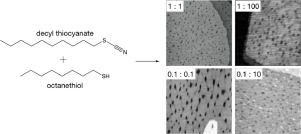当前位置:
X-MOL 学术
›
Surf. Sci.
›
论文详情
Our official English website, www.x-mol.net, welcomes your
feedback! (Note: you will need to create a separate account there.)
“Steric hindrance and exchange in the coadsorption of octanethiol and decyl thiocyanate on Au(111)”
Surface Science ( IF 2.1 ) Pub Date : 2020-04-01 , DOI: 10.1016/j.susc.2020.121562 Rejene I. Giinther , Mai Chee Lee , Annette F. Raigoza
Surface Science ( IF 2.1 ) Pub Date : 2020-04-01 , DOI: 10.1016/j.susc.2020.121562 Rejene I. Giinther , Mai Chee Lee , Annette F. Raigoza

|
Abstract Organic thiocyanates (R–SCN) form thiolate self-assembled monolayers (SAMs) on metal surfaces through the cleavage of the S–CN bond. Comparison of thiocyanate and thiol monolayers prepared using the same deposition conditions demonstrate substantial differences in the formation of the respective monolayers. These studies directly compare the self-assembly of thiocyanates and thiols. Mixed SAMs were formed through the simultaneous exposure of an Au(111) surface to octanethiol and decyl thiocyanate at different concentrations and ratios and were characterized under ambient conditions using scanning tunneling microscopy. The resulting SAMs consist primarily of octanethiolates, including when the concentration of decyl thiocyanate in solution is in excess by two orders of magnitude. Reducing the solution concentration of both octanethiol and decyl thiocyanate while maintaining the same relative ratio enhances the persistence and surface coverage of decyl thiocyanate on the surface. Thiocyanate displacement is likely facilitated by thiols, which is lessened when the octanethiol concentration is reduced. Furthermore, thiocyanate adsorption is limited by the bulkier head group. Here, we demonstrate how the deposition conditions of two compounds can be used to guide the formation of the mixed self-assembled monolayers from components with differing adsorption kinetics. This can provide greater control of the surface composition which would be useful in the patterning of surfaces.
中文翻译:

“Au(111) 上辛硫醇和癸基硫氰酸酯共吸附的空间位阻和交换”
摘要 有机硫氰酸盐 (R-SCN) 通过 S-CN 键的断裂在金属表面形成硫醇盐自组装单分子层 (SAMs)。使用相同沉积条件制备的硫氰酸盐和硫醇单层的比较表明各自单层的形成存在显着差异。这些研究直接比较了硫氰酸盐和硫醇的自组装。混合 SAM 是通过将 Au(111) 表面同时暴露于不同浓度和比例的辛硫醇和癸基硫氰酸酯而形成的,并在环境条件下使用扫描隧道显微镜进行表征。由此产生的 SAM 主要由辛硫醇组成,包括当溶液中硫氰酸癸酯的浓度超过两个数量级时。在保持相同的相对比例的同时降低辛硫醇和癸基硫氰酸酯的溶液浓度可增强硫氰酸癸酯在表面上的持久性和表面覆盖率。硫醇可能会促进硫氰酸酯置换,当辛硫醇浓度降低时,硫醇会减少。此外,硫氰酸盐的吸附受到较大头部基团的限制。在这里,我们展示了如何使用两种化合物的沉积条件来指导从具有不同吸附动力学的组分形成混合自组装单层。这可以提供对表面组成的更大控制,这将在表面图案化中有用。硫醇可能会促进硫氰酸酯置换,当辛硫醇浓度降低时,硫醇会减少。此外,硫氰酸盐的吸附受到较大头部基团的限制。在这里,我们展示了如何使用两种化合物的沉积条件来指导从具有不同吸附动力学的组分形成混合自组装单层。这可以提供对表面组成的更大控制,这将在表面图案化中有用。硫醇可能会促进硫氰酸酯置换,当辛硫醇浓度降低时,硫醇会减少。此外,硫氰酸盐的吸附受到较大头部基团的限制。在这里,我们展示了如何使用两种化合物的沉积条件来指导从具有不同吸附动力学的组分形成混合自组装单层。这可以提供对表面组成的更大控制,这将在表面图案化中有用。我们展示了如何使用两种化合物的沉积条件来指导从具有不同吸附动力学的组分形成混合自组装单分子层。这可以提供对表面组成的更大控制,这将在表面图案化中有用。我们展示了如何使用两种化合物的沉积条件来指导从具有不同吸附动力学的组分形成混合自组装单分子层。这可以提供对表面组成的更大控制,这将在表面图案化中有用。
更新日期:2020-04-01
中文翻译:

“Au(111) 上辛硫醇和癸基硫氰酸酯共吸附的空间位阻和交换”
摘要 有机硫氰酸盐 (R-SCN) 通过 S-CN 键的断裂在金属表面形成硫醇盐自组装单分子层 (SAMs)。使用相同沉积条件制备的硫氰酸盐和硫醇单层的比较表明各自单层的形成存在显着差异。这些研究直接比较了硫氰酸盐和硫醇的自组装。混合 SAM 是通过将 Au(111) 表面同时暴露于不同浓度和比例的辛硫醇和癸基硫氰酸酯而形成的,并在环境条件下使用扫描隧道显微镜进行表征。由此产生的 SAM 主要由辛硫醇组成,包括当溶液中硫氰酸癸酯的浓度超过两个数量级时。在保持相同的相对比例的同时降低辛硫醇和癸基硫氰酸酯的溶液浓度可增强硫氰酸癸酯在表面上的持久性和表面覆盖率。硫醇可能会促进硫氰酸酯置换,当辛硫醇浓度降低时,硫醇会减少。此外,硫氰酸盐的吸附受到较大头部基团的限制。在这里,我们展示了如何使用两种化合物的沉积条件来指导从具有不同吸附动力学的组分形成混合自组装单层。这可以提供对表面组成的更大控制,这将在表面图案化中有用。硫醇可能会促进硫氰酸酯置换,当辛硫醇浓度降低时,硫醇会减少。此外,硫氰酸盐的吸附受到较大头部基团的限制。在这里,我们展示了如何使用两种化合物的沉积条件来指导从具有不同吸附动力学的组分形成混合自组装单层。这可以提供对表面组成的更大控制,这将在表面图案化中有用。硫醇可能会促进硫氰酸酯置换,当辛硫醇浓度降低时,硫醇会减少。此外,硫氰酸盐的吸附受到较大头部基团的限制。在这里,我们展示了如何使用两种化合物的沉积条件来指导从具有不同吸附动力学的组分形成混合自组装单层。这可以提供对表面组成的更大控制,这将在表面图案化中有用。我们展示了如何使用两种化合物的沉积条件来指导从具有不同吸附动力学的组分形成混合自组装单分子层。这可以提供对表面组成的更大控制,这将在表面图案化中有用。我们展示了如何使用两种化合物的沉积条件来指导从具有不同吸附动力学的组分形成混合自组装单分子层。这可以提供对表面组成的更大控制,这将在表面图案化中有用。











































 京公网安备 11010802027423号
京公网安备 11010802027423号